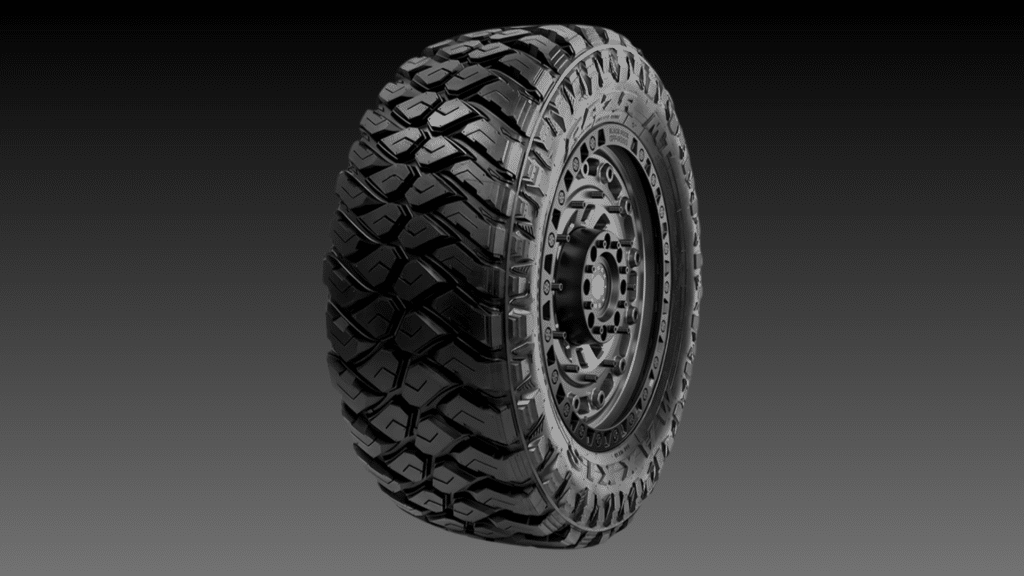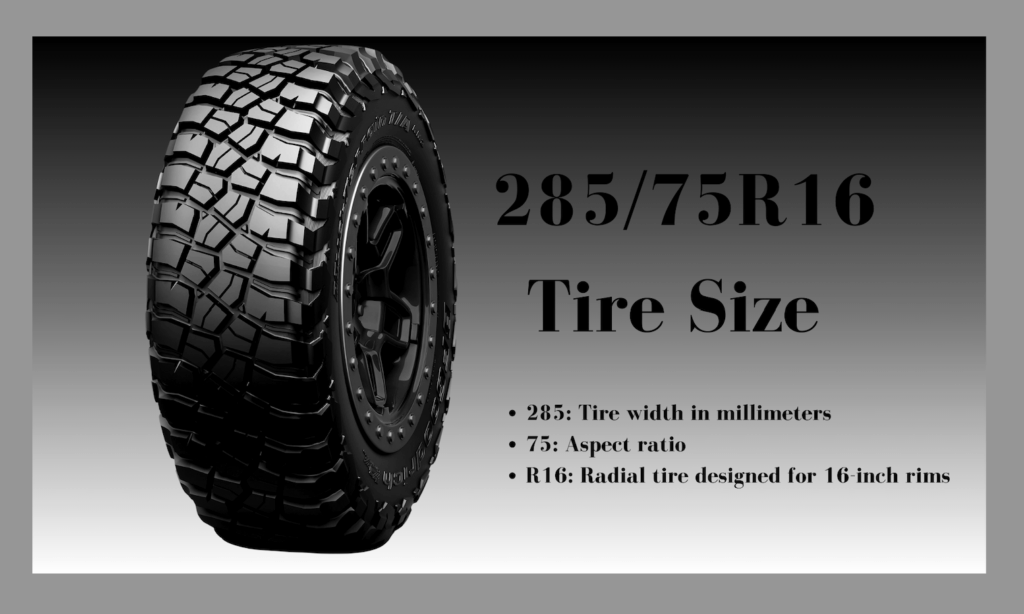Tire sizes can feel like a math puzzle, especially with numbers like 285/75R16.
If you’re confused by these measurements, you’re not alone. Many car owners struggle to understand their tire dimensions in inches.
These numbers are important because they affect how your car handles and stays safe on the road.
The good news is that converting 285/75R16 to inches is easy!
In this guide, I’ll show you how to do it step by step. You’ll learn exactly what each number means and how to convert them without the complicated math.
As a certified automotive specialist with 15+ years of experience, I’ll show you exactly how to convert these measurements without any complicated math.
What Does 285/75R16 Represent?

Let’s break down what 285/75R16 means for your vehicle:
- 285: This is the tire’s width in millimeters, measured from sidewall to sidewall. It’s like the tire’s footprint on the road.
- 75: This is the aspect ratio. It tells you how tall the tire’s sidewall is compared to its width. In this case, the sidewall height is 75% of the tire’s width.
- R: This stands for radial, the most common type of tire.
- 16: This is the size of the wheel rim the tire fits, measured in inches.
Why does this matter? These numbers help you:
- Choose tires that fit your wheels
- Keep your speedometer accurate
- Ensure the tires work well with your vehicle
Converting 285/75R16 to Inches
Let’s convert those metric numbers into inches.
I’ll show you how to do it step by step.
First, let’s convert the width (285mm)
To change millimeters to inches, divide by 25.4: 285 ÷ 25.4 = 11.2 inches wide
Now for the sidewall height:
- Take the width (285mm) and multiply it by the aspect ratio (75%)
- 285 × 0.75 = 213.75mm sidewall height
- Convert to inches: 213.75 ÷ 25.4 = 8.4 inches
Total tire diameter calculation:
- Double the sidewall height (8.4 × 2 = 16.8 inches)
- Add the rim size (16 inches)
- 16.8 + 16 = 32.8 inches total diameter
So your 285/75R16 tire measures:
- Width: 11.2 inches
- Sidewall height: 8.4 inches
- Total diameter: 32.8 inches
I’ve rounded these numbers to one decimal place to keep things simple.
You can use these measurements when comparing different tire sizes or checking if a new set will fit your vehicle.
Converting 285/75R16 to Millimeters
Sometimes, you’ll need to convert tire measurements to millimeters, especially when comparing specs from other countries.
Converting inches to millimeters is simple: multiply your inch measurements by 25.4.
Here’s the conversion for the 285/75R16 tire:
- Width: 11.2 inches × 25.4 = 285 millimeters
- Sidewall height: 8.4 inches × 25.4 = 213.75 millimeters
- Total diameter: 32.8 inches × 25.4 = 833 millimeters
These metric measurements are useful for:
- Ordering tires from international sellers
- Checking vehicle manufacturer specs
- Comparing tire sizes across different brands
Mastering the Art of Reading 285/75R16 Tire Size
The Width (285)
This number shows how wide your tire is from side to side.
Picture placing a ruler across your tire’s tread – that’s what this measures.
In this case, 285 millimeters or 11.2 inches of rubber meets the road.
The Aspect Ratio (75)
Think of this as the tire’s profile height.
The 75 means the sidewall is 75% as tall as the tire is wide.
A higher number means a taller tire, while a lower number means a shorter, sportier look.
The Construction and Rim Size (R16)
The ‘R’ indicates a radial tire, and the’ 16′ indicates that it fits a 16-inch wheel.
Tips for Choosing the Right Size
Check your vehicle manual first
- It lists the sizes that work best for your car
- You’ll find important load ratings too
Compare the full-size
- The width must match your wheels
- The total diameter should stay close to the original
- Aspect ratio affects handling
Look for the size markings
- Find them on your current tire’s sidewall
- They’re usually raised and easy to read
This knowledge helps you make smart choices when buying new tires.
It’s like having a map that guides you to the right fit for your vehicle.
How Wide Is a 285/75R16 Tire?
285 millimeters = 11.22 inches wide
To put this width in perspective, here’s how it compares to other common tire sizes:
- 235mm (9.25 inches) – typical for many passenger cars
- 265mm (10.43 inches) – common for light trucks
- 285mm (11.22 inches) – your tire size
- 305mm (12 inches) – often used on larger trucks
What this width means for you: A wider tire like the 285mm gives you:
- More rubber touching the road
- Better grip in dry conditions
- Increased stability when carrying loads
Size comparison tip: Stand a dollar bill on its end – it’s about 6 inches tall.
Your tire’s width is nearly twice that length.
This gives you a real-world reference for visualizing the size.
Understanding the Sidewall Height of 285/75R16 Tires
The 75 in your tire size means the sidewall is 75% as tall as the tire is wide. Here’s the math:
- Tire width: 285mm
- Multiply by 75%: 285 × 0.75 = 213.75mm
- Convert to inches: 213.75 ÷ 25.4 = 8.4 inches
What Does This Sidewall Height Do for You
A taller sidewall, like 8.4 inches,s affects your ride in several ways:
- Gives better cushioning over bumps
- Helps protect your wheels from rocks
- Makes the ride more comfortable
- Works well for off-road driving
Size in Real Terms
Picture a standard water bottle – your tire’s sidewall is about as tall as that.
This height helps your tire flex and absorb bumps in the road.
I recommend this sidewall height if you:
- Drive on rough roads often
- Want more comfort in your ride
- Need good off-road performance
- Want to protect your wheels
The taller sidewall acts like a cushion between your wheels and the road, helping smooth out those bumps and dips you drive over.
What Rim Size Works Best for a 285/75R16 Tire?
The right rim width matters, too. For a 285mm tire, here’s what works best:
- Minimum width: 7.5 inches
- Maximum width: 9 inches
- Sweet spot: 8 inches
What Happens with Different Rim Widths
Too narrow (under 7.5 inches):
- Tire bulges out at sides
- Makes steering less precise
- Might wear unevenly
Too wide (over 9 inches):
- Tire looks stretched
- Less sidewall protection
- Could damage the tire
How to Pick the Best Width
Start by checking these things:
- Your vehicle’s manual
- Load you typically carry
- Type of driving you do
- Local road conditions
Quick check tip: Look at your current rims – their size is usually stamped on the back or inside edge.
This helps you know what you’re working with before making changes.
Decoding the Circumference of a 285/75R16 Tire
- First, we need a total diameter of 32.8 inches
- Multiply by Pi (3.14159) to get the circumference
- 32.8 × 3.14159 = 103 inches per rotation
What this means for your vehicle
Small changes in tire size affect:
- Speed readings on your dashboard
- Miles per gallon
- Engine RPM at highway speeds
Real-world impact
If your speedometer was set for smaller tires, here’s what happens:
- When it shows 60 mph, you might be going faster
- Your odometer will read fewer miles than you’ve driven
- Your engine might run at a lower RPM for the same speed
Fuel use effects
Larger circumference means:
- The engine turns slower at the same speed
- It might save some fuel on highways
- It could feel different when accelerating
Exploring Alternate Replacement Sizes for 285/75R16 Tires
Similar size options you can use
- 275/70R16 (slightly smaller)
- 295/75R16 (slightly wider)
- 285/70R16 (shorter sidewall)
What happens if you go smaller
Using 275/70R16 gives you:
- Better fuel numbers
- Quicker steering response
- Lower cost typically
- Less chance of rubbing
What happens if you go bigger
Using 295/75R16 means:
- More grip off-road
- Better looks for some trucks
- Higher cost usually
- Might need a lift kit
Vehicle fits
These tires typically work well on:
- Ford F-150s
- Chevy Silverados
- Toyota Tundras
- Dodge Rams
I suggest measuring your wheel wells before changing sizes. Check for:
- Space between tire and fender
- Room for full steering turns
- Clearance when hitting bumps
A quick tip: Ask your local tire shop about recent fits on your exact vehicle model.
They often know what works best from real-world experience.
Remember: changing tire size affects your speedometer reading. Keep this in mind for safe, legal driving.
Tire Size Comparison: 285/75R16 vs. Common Alternative Sizes
When it comes to selecting tire sizes, understanding the difference between options can help you choose the best fit for your vehicle.
Here’s a quick comparison between 285/75R16 and a couple of commonly used alternative sizes:
1. 285/75R16 vs. 275/70R16
- Width: The 285/75R16 is 11.2 inches wide, while the 275/70R16 is slightly narrower at 10.8 inches.
- Sidewall Height: The sidewall of the 285/75R16 tire is 8.4 inches high, compared to 7.7 inches for the 275/70R16. This means the 285/75R16 has a taller sidewall, offering more cushioning for a smoother ride.
- Total Diameter: The 285/75R16 has a larger total diameter of 32.8 inches, while the 275/70R16 comes in at 31.2 inches, making it slightly smaller.
- Fitment: The 275/70R16 offers a better fit for vehicles with limited clearance, and it’s a good choice for drivers looking for better fuel economy, quicker steering, and lower costs.
2. 285/75R16 vs. 295/75R16
- Width: The 295/75R16 is 12 inches wide, which is 0.8 inches wider than the 285/75R16.
- Sidewall Height: Both tires share the same sidewall height of 8.4 inches.
- Total Diameter: The 295/75R16 has a larger diameter of 33.2 inches, which is 0.4 inches bigger than the 285/75R16.
- Fitment: The 295/75R16 is often chosen for trucks looking for better off-road performance and traction. However, it may require a lift kit to prevent rubbing in vehicles with limited wheel-well space.
Summary of Differences:
- 285/75R16 vs. 275/70R16: The 285/75R16 is wider with a larger sidewall and diameter, making it more suited for those who want enhanced off-road performance and a smoother ride.
- 285/75R16 vs. 295/75R16: The 295/75R16 provides better grip and traction, particularly in off-road conditions, but might require additional modifications like a lift kit to fit.
Always check the clearance and fitment before upgrading to a different tire size.
If you’re unsure, consult with your local tire shop to ensure compatibility with your vehicle.
Conclusion
Understanding tire sizes makes it easier to choose the right tires for your vehicle.
For the 285/75R16 tire, here are the key measurements:
- Width: 11.2 inches
- Sidewall: 8.4 inches
- Total diameter: 32.8 inches
Ready to upgrade your tires?
Make your next tire purchase with confidence.
If you’re unsure, take this guide to your local tire shop. They’ll appreciate working with someone who understands tire measurements.
Got more questions about tire sizes?
Feel free to leave a comment below. I’m here to help you find the best fit for your vehicle!
Frequently Asked Questions
How Can I Find My Current Tire Size?
Look for a code like P285/75R16 on your tire’s sidewall.
It’s usually raised and visible.
You can also check your vehicle’s door jamb or owner’s manual.
What’s The Speed Rating On A 285/75R16 Tire?
Most 285/75R16 tires come with Q to R speed ratings, suitable for speeds up to 99-106 mph, depending on the specific tire model.
Will Larger Tires Affect My Transmission?
Yes – bigger tires make your transmission work harder since it moves more weight.
This might affect shift points and overall performance.
Do I Need To Reprogram My Speedometer After Changing Tire Sizes?
If the new tires have a circumference more than 3% different from the old ones, you should get your speedometer recalibrated.
Can I Mix Different Tire Sizes On My Vehicle?
No – all four tires should be the same size.
Different sizes can damage your differential and cause handling problems.


